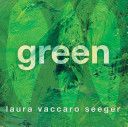
Green
Written and illustrated by Laura Vaccaro Seeger
Roaring Brook Press, 2012, pp.
ISBN: 978-1596433977
A master of concept books, Laura Vaccaro Seeger has created a book that indulges readers in the color green through images and a few carefully selected words. The various shades of green represent contexts of different global communities that are connected from page to page by the intersecting colors and die cuts that provide a peek from one illustration to the next. Sensory imagery abounds visually and linguistically, intersecting with the tactile, imagined scents, sharp tastes, and distinctive sounds. The limited verbiage takes readers to deeper levels of conceptual understanding through adjectives such as “wacky,” “slow,” and “glow” followed by yet another perspective on green-related concepts through conditional descriptors: “all green,” “never green,” “no green,” and “forever green.”
Seeger received a BFA degree at the School of Fine Art and Design at New York State University at Purchase and began her career in the field of animated television. Once she began publishing children’s books, her unique concept books claimed many honors, including the Caldecott Honor Book, Geisel Honor Book, Globe-Horn Book award, and ALA Notable Book Award as well as the Children’s Literature Assembly’s Notable Children’s Books in the Language Arts award list and the IRA Teachers Choices award lists.
Green is Seeger’s second Caldecott Honor Book and was nominated for the IBBY Books for Young People with Disabilities list. Green is an excellent example of one type of book considered for this award because the book can be a significant text for young people with language-disabilities or difficulties with visual perception. By exploring the many ways in which a basic color can be described and how it is identified throughout the natural world, readers can internalize relevant language use, extend their vocabulary, and build upon their understandings of sensory imagery and concepts. Clear colors and contrasts are essential for those challenged with visual perceptions. Seeger’s book capitalizes on this artistic focus with bold colors reflecting the diversity of contexts in which the color green is predominant.
As a book identified to be exceptional for children with disabilities—especially those with challenges of language and conceptual understanding—Green encourages all readers to be more aware of the many variations of color around them, both green and other hues. A discussion with younger readers might invite them to share where they observe green in their communities and how they might describe this particular green. Seeger’s vocabulary use is minimal but specific in that it categorizes each shade according to where it is found in nature. It is interesting to note that the only “never green” instance is one that is man made—a stop sign.
Other books that might encourage the development of language and concepts as well as visual acuity can be found in Seeger’s own creations: First the Egg (2007), Lemons Are Not Red (2004), and The Hidden Alphabet (2003). To continue exploring the many dimensions of color, Green might be followed by The Black Book of Colors (Menena Cottin, 2010), Red Sings from Tree Tops, A Year in Colors (Joyce Sidman, 2009), One (Kathryn Otashi, 2008), or A Blue So Blue (Jean-FranCois Dumont, 2005).
Janelle Mathis, University of North Texas, Denton, TX
WOW Review, Volume V, Issue 4 by Worlds of Words is licensed under a Creative Commons Attribution-NonCommercial-ShareAlike 4.0 International License. Based on work at https://wowlit.org/on-line-publications/review/v-4/
